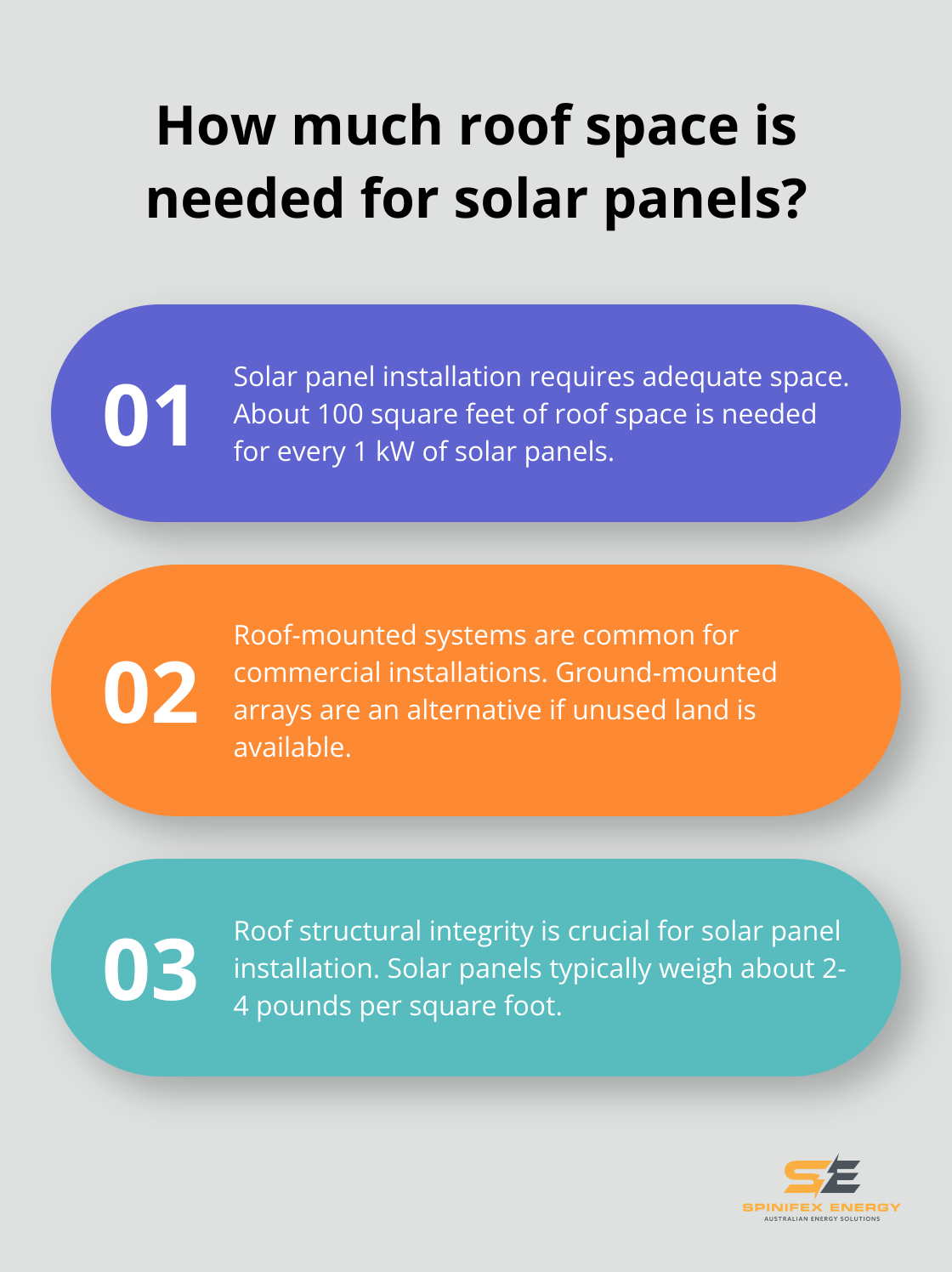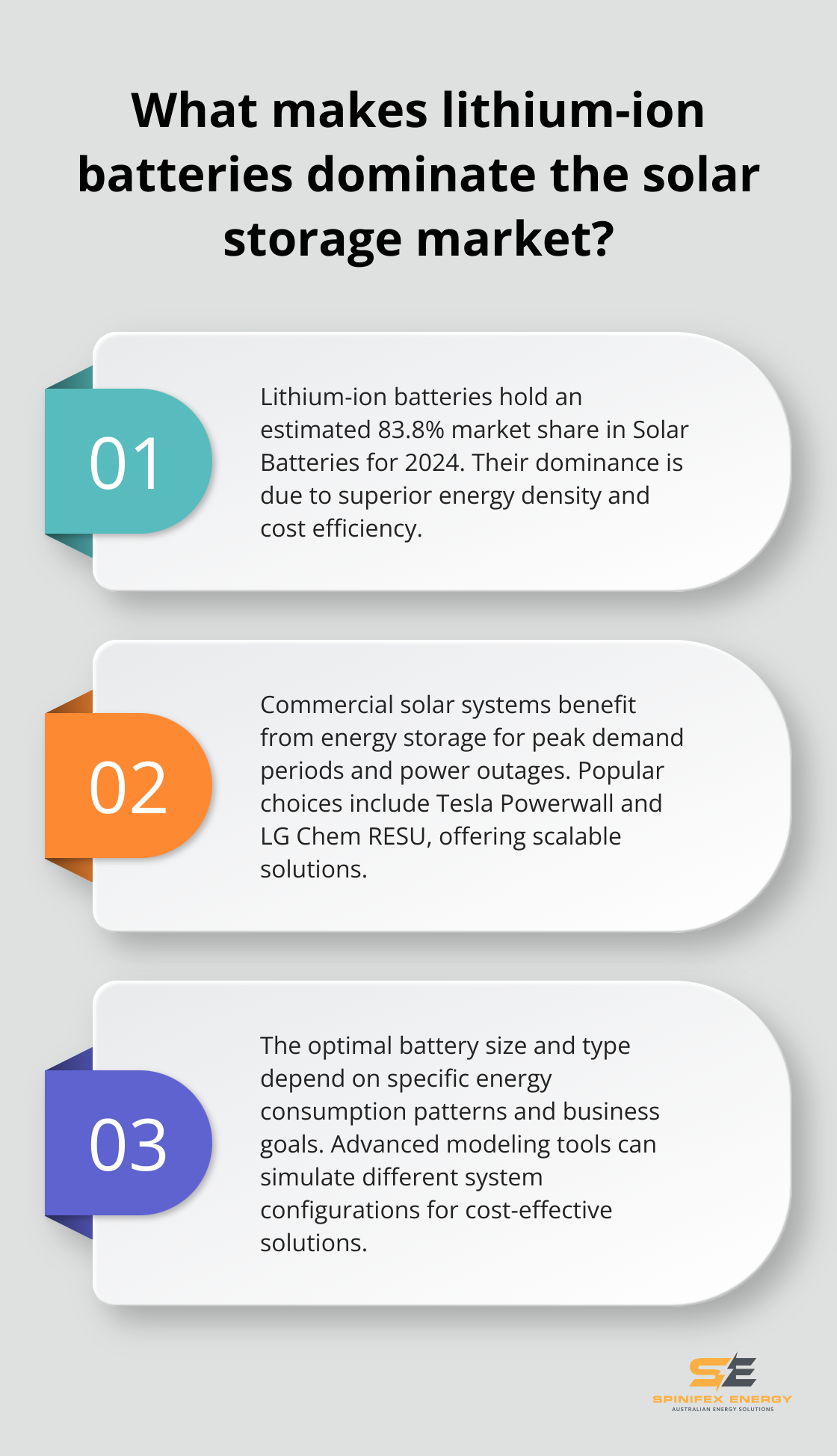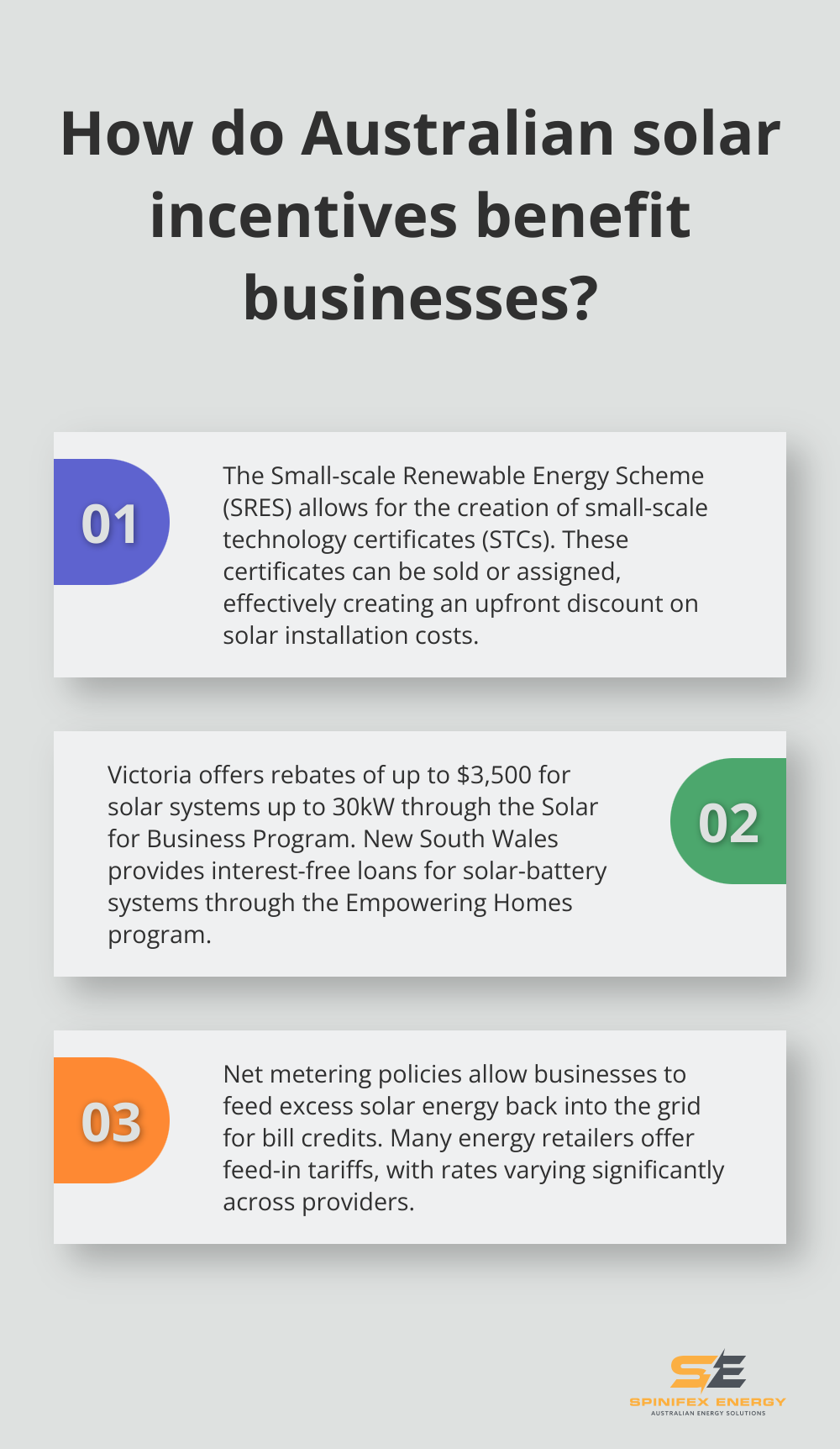At Spinifex Energy, we know that designing a commercial solar energy system is a game-changer for businesses looking to reduce costs and boost sustainability.
The process involves careful planning, from assessing energy needs to selecting the right components and navigating regulations.
In this guide, we’ll walk you through the key steps to create an efficient and cost-effective solar solution for your company.
How to Assess Your Energy Needs and Site Conditions
Analyze Your Energy Consumption
The first step in designing an effective commercial solar energy system is a thorough assessment of your energy needs. Learn how to read your energy bill after installing solar panels. This data will reveal your average monthly consumption and any seasonal patterns. Identify peak usage periods and times when your demand is lower. Understanding feed-in tariffs, solar credits, and rebates can help you optimize your consumption patterns.

Consider your future energy needs. Do you plan to expand your operations or add energy-intensive equipment? Factor in a 10-20% increase in energy requirements to future-proof your solar system.
Evaluate Your Site
The available space for solar panel installation is a key factor in system design. Roof-mounted systems are common, but ground-mounted arrays might suit you if you have unused land. Measure your roof area or available ground space accurately. You need about 100 square feet of roof space for every 1 kW of solar panels (as a general rule of thumb).
Assess the structural integrity of your roof if you’re considering a rooftop installation. Older roofs might need reinforcement to support the additional weight of solar panels, which typically weigh about 2-4 pounds per square foot.
Determine Solar Potential
Your location plays a significant role in solar potential. Australia has some of the highest solar radiation per square meter of any continent, making it ideal for solar energy. However, local factors like shading can impact system performance.
Conduct a shade analysis throughout the day and across seasons. Even partial shading can significantly reduce a solar panel’s output. The Solar Potential Map by the Australian PV Institute shows the estimated percentage of houses with solar PV systems installed in every council in Australia and provides insights into your site’s solar potential.
Consider the orientation and tilt of your roof or ground space. In Australia, north-facing panels typically produce the most energy, but east-west configurations can also be effective for businesses with high morning and afternoon energy demands.
Seek Professional Assessment
While initial self-assessment is valuable, professional assessment tools and expertise can provide even more accurate insights. Companies like Spinifex Energy offer tailored energy consulting services to optimize your electricity expenses. Their data-driven approach ensures you make informed decisions about your commercial solar energy system.
With a comprehensive understanding of your energy needs and site conditions, you’re ready to move on to the next critical step: choosing the right components for your solar energy system.
What Components Make a Great Commercial Solar System?
Solar Panels: The Powerhouse of Your System
The selection of solar panels forms the foundation of an effective commercial solar energy system. Polycrystalline solar panels are cheaper than monocrystalline panels, however, they are less efficient and aren’t as aesthetically pleasing. Thin film solar panels represent a newer technology gaining traction in the market. Their flexibility and lightweight nature make them ideal for roofs that can’t support traditional panels.
Inverters: The Power Conversion Experts
The choice between string inverters and microinverters can significantly impact system performance. String inverters, traditionally used in commercial settings, offer lower costs and easier maintenance. They excel in installations with consistent sunlight exposure across all panels.

Microinverters, while pricier, provide panel-level optimization. This feature ensures that shading or malfunction of one panel doesn’t affect the entire system’s performance. They prove particularly beneficial for roofs with partial shading or complex layouts.
Power optimizers offer a middle ground (combining cost-effectiveness of string inverters with some microinverter benefits). They merit consideration for installations with varying roof angles or partial shading issues.
Mounting Systems: The Structural Backbone
The decision between roof-mounted and ground-mounted systems depends on available space and site conditions. Roof-mounted systems dominate commercial buildings, utilizing existing structures and preserving ground space. They typically cost less to install but require a structurally sound roof.
Ground-mounted systems offer more flexibility in orientation and angle, potentially increasing energy production. They provide easier access for maintenance but require available land and may incur higher installation costs due to additional groundwork and support structures.
Energy Storage: The Power Bank
The incorporation of battery storage into a commercial solar system can enhance its value significantly. Lithium-ion batteries are a leading product type in the Solar Batteries market, with an estimated share of 83.8% in 2024, owing to their superior energy density and cost efficiency.
Energy storage allows the use of solar power during peak demand periods or when solar production dips, reducing reliance on grid electricity during expensive times. For businesses in areas prone to power outages, batteries provide crucial backup power, ensuring operational continuity.
Popular choices for commercial applications include the Tesla Powerwall and LG Chem RESU (offering scalable solutions tailored to specific energy needs). However, the optimal battery size and type depend on unique energy consumption patterns and goals.
The selection of these components requires careful consideration of how they work together to meet specific energy needs. Advanced modeling tools can simulate different system configurations, ensuring the most cost-effective and efficient solution for any business. As we move forward, it’s important to understand how regulations and incentives can further shape the design and implementation of a commercial solar energy system.
How to Navigate Solar Regulations and Incentives
Local Zoning Laws and Building Codes
Before you install a solar system, you must understand local zoning laws and building codes. These regulations differ by council and affect system size, placement, and installation requirements. Some areas have height restrictions or setback requirements that impact rooftop installations.

Contact your local council’s planning department early. They will provide specific guidelines and necessary permit applications. Some councils offer expedited permitting for solar installations, which can save time and reduce bureaucratic obstacles.
Federal and State Incentives
The Australian government offers several incentives to promote commercial solar adoption. The Small-scale Renewable Energy Scheme (SRES) allows for the creation of small-scale technology certificates (STCs) when installing an eligible system. These certificates have a value that can be redeemed by selling or assigning them, effectively creating an upfront discount on installation costs.
STC values fluctuate based on market conditions, but they can significantly reduce initial costs.
State-level incentives vary. Victoria offers the Solar for Business Program, which provides rebates of up to $3,500 for systems up to 30kW. New South Wales has introduced the Empowering Homes program, offering interest-free loans for solar-battery systems.
Net Metering Policies
Net metering allows businesses to feed excess solar energy back into the grid in exchange for credits on their electricity bills. While not uniformly available across Australia, many energy retailers offer feed-in tariffs. These rates vary significantly.
Research different energy retailers to find the most favorable feed-in tariff rates. Some retailers also offer time-of-use tariffs, which can benefit your business if you can shift energy consumption to times when solar production peaks.
Power Purchase Agreements (PPAs)
Power Purchase Agreements offer an alternative financing model for businesses hesitant about upfront costs. With a Solar PPA, businesses can benefit from predictable and competitive energy costs, contributing to long-term financial stability.
PPAs can provide immediate savings without capital expenditure. However, they are complex agreements that require careful consideration. You must understand the long-term implications, including potential buyout options and what happens at the end of the agreement term.
Expert Guidance
The regulations and incentives surrounding commercial solar can be complex. Working with experienced solar providers simplifies this process. Their expertise in navigating regulatory landscapes and optimizing incentives ensures you maximize the financial and operational benefits of your commercial solar investment.
Final Thoughts
Designing a commercial solar energy system requires careful planning and expertise. From energy assessment to component selection and regulatory navigation, each step shapes an efficient and cost-effective solution for your business. The long-term benefits of solar energy for businesses extend beyond immediate cost savings, offering energy independence and a reduced carbon footprint.

Working with experienced professionals proves paramount to the success of your solar investment. Their expertise helps avoid common pitfalls, optimize system design, and maximize financial benefits. At Spinifex Energy, we offer tailored energy consulting services to optimize your electricity expenses through advanced commercial solar power systems.
A well-designed commercial solar energy system positions businesses for long-term financial success and operational efficiency. As energy costs rise, your solar investment will provide increasingly valuable returns (securing your business against future price volatility). The path to solar adoption may seem complex, but the rewards make the effort worthwhile.

